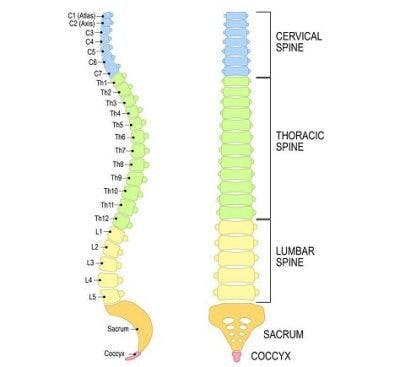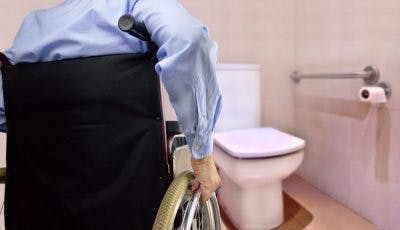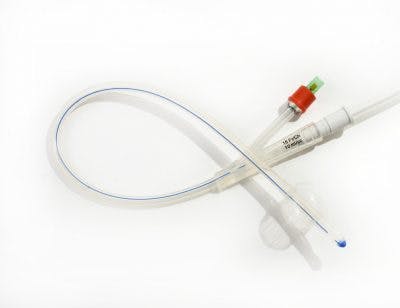what to do with loss of bowel movement after spinal cord surgery
Regaining bladder control after spinal cord injury may or may not exist possible depending on the severity of your injury.
About 80% of spinal cord injury patients experience some loss of float control due to nerve harm, also known as neurogenic bladder dysfunction.
This article will explicate why bladder dysfunction is so common later a spinal string injury and discuss various scenarios where bladder command tin can render.
What Causes Loss of Bladder Control After Spinal Cord Injury?
The spinal cord transmits messages betwixt the encephalon and body. Yet, after a spinal cord injury, messages may non be able to get by the site of injury, resulting in paralysis and loss of sensation beneath your level of injury.
Many people lose control of bladder functions later a spinal string injury considering the bladder muscles are innervated by some of the lowest nervus segments of the spinal string. Harm to the spinal cord not only affects functions at the injury site only can too affect all functions below.
The reason why some spinal cord injury patients take normal bladder functions is considering they have incomplete SCIs, which means some connections were non damaged by the injury. As a result, they may have some preserved motor command and sensation below their level of injury.
Next, we'll talk over different types of neurogenic bladder dysfunction that can upshot from spinal cord injury.
Agreement the Different Types of Neurogenic Float Dysfunction

Two types of neurogenic bladder dysfunction can occur after a spinal cord injury: suprasacral and sacral.
Because bladder functions are innervated past the sacral region, impairment at or below the sacral nerves will result in different outcomes than harm above.
Suprasacral Bladder Dysfunction
Suprasacral float dysfunction occurs afterwards cervical, thoracic, or lumbar spinal cord injuries (areas above the sacral region).
This blazon of float dysfunction results in a spastic float (meaning the bladder reflex is essentially 'over-active' and the bladder may involuntarily contract without warning). This can crusade urge incontinence, where individuals are non able to control their bladder functions.
When the bladder fills upward, the increased pressure sets off a reflex, causing the sphincter to relax and involuntarily release urine, nevertheless emptying is frequently incomplete. Additionally, individuals with this status may feel like they demand to utilize the bathroom even when their bladder is not total.
In other words, due to impaired communication between the brain and the bladder and an over-active bladder reflex, individuals with injuries above the sacral region are oftentimes prone to bladder-related accidents.
Sacral Bladder Dysfunction
If your spinal cord injury occurs in the sacral region, information technology directly affects your bladder reflex and denervates the sphincter, causing flaccid bladder.
Flaccid bladder is characterized by low muscle tone. The detrusor (a muscle of the bladder that normally contracts to push urine out) is an extremely flexible muscle; nevertheless, when it is relaxed, it can cause the float to retain lots of urine and ultimately become also full. With this condition, when the bladder gets too full, information technology will and so overflow causing accidents (overflow incontinence).
Poorly managed neurogenic bladder dysfunction can crusade more serious complications including:
- Urinary tract infections
- Hydronephrosis (kidney swelling due to urine build-up)
- Kidney stones or urinary calculi
- Float cancer
In other words, due to lack of muscle tone, the bladder muscles remain in a relaxed and expanded country. As a result, the bladder can store more urine, which can be harmful because holding urine for as well long can increment your risk for infections or kidney complications.
In the following department, we'll talk over why loss of bladder command may be nearly astringent immediately after a spinal cord injury.
Why Some People Regain Bladder Office Relatively Apace
For some, loss of float control can be temporary. After a spinal string injury, you lot may experience the temporary and consummate loss of reflexes below your level of injury called spinal shock.
This is primarily caused by reduced blood supply and inflammation. Blood is rich in oxygen and nutrients that are essential for cellular activeness. Excessive swelling in the spinal string tin can decrease claret catamenia by upward to eighty%, causing major bodily functions to dysfunction.
Fortunately, spinal stupor is a temporary condition that can terminal anywhere from a few days to several months. In one case inflammation of the spinal cord starts to die downwards, functions beneath the level of injury may gradually start to return.
Just is information technology possible to regain bladder command after spinal stupor subsides?
Is Regaining Bladder Control After Spinal Cord Injury Possible?

Every spinal cord injury is unique, but as long equally spared neural pathways exist at the site of injury (meaning information technology is an incomplete injury), regaining bladder function may be possible.
Spared neural pathways refer to undamaged connections at the location of injury that let for advice between the encephalon and areas beneath the level of injury. They provide hope for recovery considering they are capable of utilizing neuroplasticity, the central nervous system'due south ability to rewire itself.
By consistently stimulating the spinal cord through task-specific practice, individuals may be able to improve weakened functions. The more than spared neural pathways be, the ameliorate the potential for recovery.
While regaining bladder function later on spinal cord injury cannot be guaranteed, there are many means to finer manage neurogenic bladder dysfunction and improve your quality of life.
Bladder Management After Spinal String Injury

Proper direction of neurogenic bladder dysfunction is essential for optimizing quality of life after spinal string injury.
Management interventions primarily focus on elimination the bladder before it gets likewise full, however the specifics of a bladder intervention plan will depend on the location of the injury.
Catheterization is the well-nigh common class of bladder management later SCI. It involves inserting a narrow tube into the body to drain urine from the bladder.
There are two main types of catheterization:
Intermittent catheterization requires using a catheter every iv-six hours to empty the float. If you prefer not to exist connected to a catheter all the fourth dimension, this method is ideal.
Indwelling catheterization involves beingness connected to a catheter at all times. This method brings higher risk of a UTI, and is typically only used if there is a specific reason the individual cannot perform intermittent catheterization.
Culling bladder management interventions include:
- Electric stimulation involves implanting an electrode array to the lesser of the spine. The device emits electric currents beneath the site of injury to excite the neurons and enhance motor function.
- Anticholinergic medications are often the commencement line of treatment for overactive bladders considering they tin can block chemicals that crusade musculus contractions, which helps increase bladder capacity and reduce bladder pressure.
- Bladder augmentation surgeryenlarges the bladder walls and so individuals don't accept to empty the float and then frequently.
- Botox injections tin can temporarily denervate spastic bladder muscles to increase float book and salve high bladder pressure.
Depending on your lifestyle and the severity of symptoms, some management interventions will be more ideal than others. Talk to your md to run across which treatments will be best for yous.
Regaining Bladder Control After Spinal Cord Injury: Key Points
Loss of bladder control is one of the most common outcomes of spinal cord injury. While it might be possible to improve bladder control, the outcomes of every SCI are different.
Learning to manage bladder problems is essential to avoid accidents and prevent further complications from developing.
Hopefully, this article helped yous better understand how spinal cord injury can touch bladder functions and how to manage complications to improve your quality of life. Skilful luck!
©iStock.com/DragonImages/Manuel-F-O
schneidertheried75.blogspot.com
Source: https://www.flintrehab.com/regaining-bladder-control-after-spinal-cord-injury/
0 Response to "what to do with loss of bowel movement after spinal cord surgery"
Post a Comment